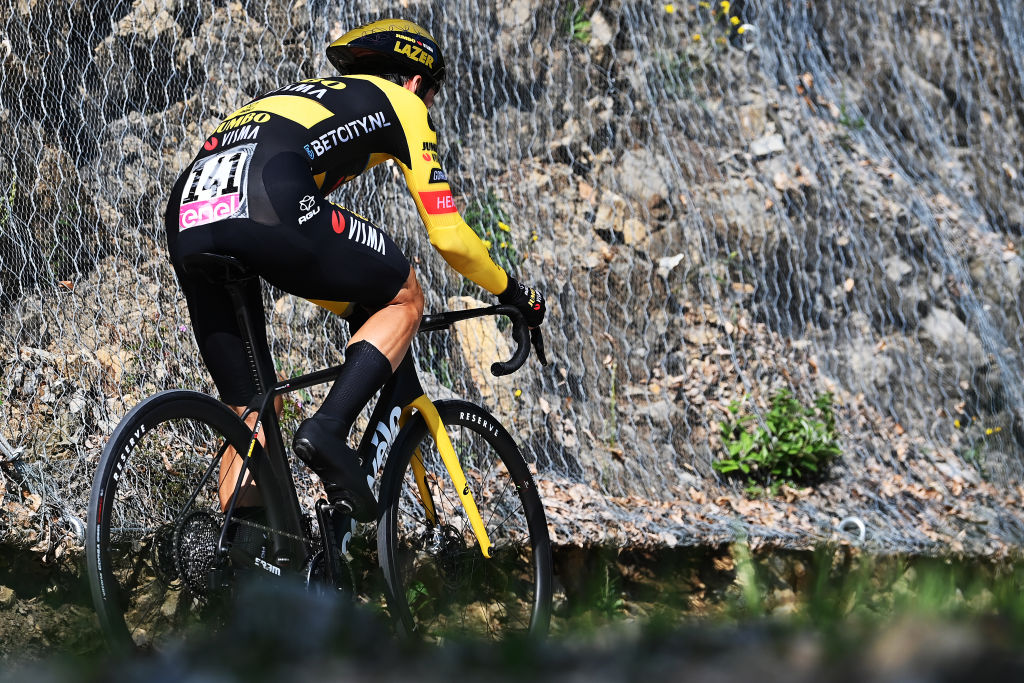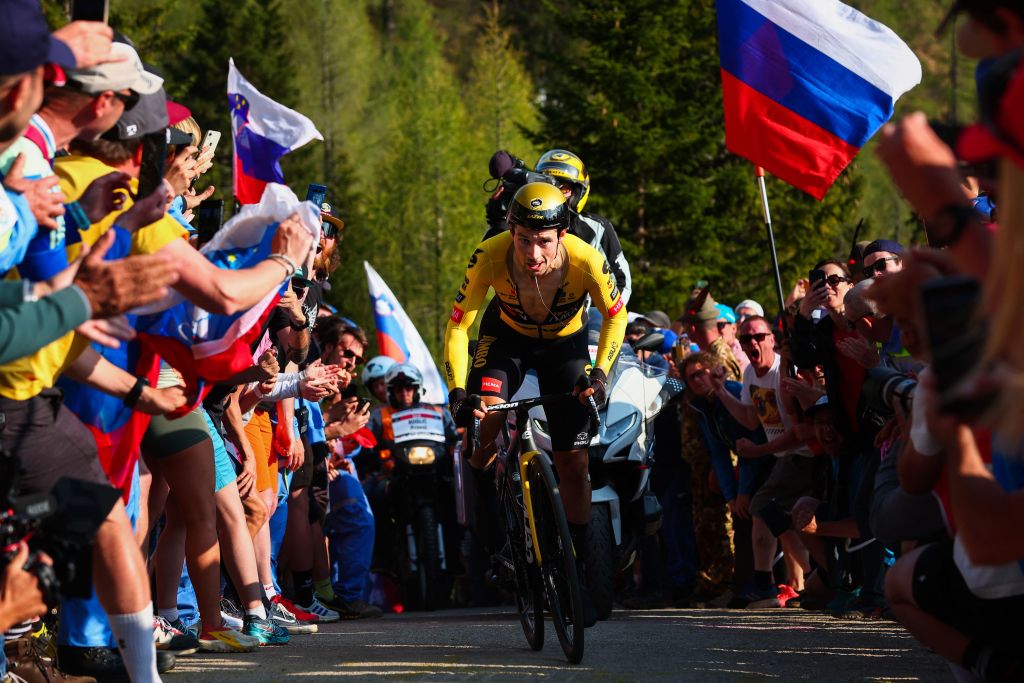Twenty seconds of panic – Primoz Roglic defies mechanical to win Giro d’Italia
‘In a moment like this, when the pressure was so high, he stayed so calm’

Primož Roglič’s Jumbo-Visma teammates sat together atop Monte Lussari on Saturday afternoon, locked somewhere between fear and hope as they watched events unfold on the big screen past the finish line. It was hard not to think of La Planche des Belles Filles and all that.
The 2023 Giro d’Italia, just like the 2020 Tour de France, would be decided by a hybrid mountain time trial on the penultimate day. On that occasion, Roglič was trying to defend the yellow jersey against a fellow Slovenian. Here, he was vying to snatch the maglia rosa at the last, cheered on by the thousands of compatriots who had made the short trip across the border.
The circumstances were different, but the energy was the same. Tom Dumoulin and Wout van Aert’s anxious expressions of three years ago were mirrored by those of Sepp Kuss and Sam Oomen here. The patchy information on the time gaps between Roglič and Geraint Thomas (Ineos Grenadiers) only added to the general sense of jitteriness.
When the speaker at the finish announced, in Italian, that Roglič had already pulled back 16 seconds on Thomas at the second intermediate check, Oomen threw his hands up in annoyance: “Say it in English too!” Confirmation from the on-screen graphic did little to defuse the prevailing tension.
'I always have hope and fight on' - Primoz Roglic inspired by Slovenian fans at Giro d'Italia
Giro d'Italia: Primoz Roglic poised for overall victory with stage 20 mountain time trial win
'It's not a circus, it's amazing' - Riders suffer, enjoy Giro d'Italia's mountain TT
Giro d'Italia 2023 - the definitive guide
Moments later, a guttural cry emerged from Jumbo-Visma huddle. Oomen stood up and walked in a circle before sitting down again. The television pictures now showed Roglič standing in the road, trying to re-ship a slipped chain. A litany of misfortunes has been visited upon Roglič over the years in Grand Tours, but losing the Giro because of an episode like this would have added a whole new wing to that particular house of pain.
From the pillion of the following motorbike, Roglič’s directeur sportif Marc Reef watched the moment unfold almost in slow motion. The Jumbo-Visma mechanic, travelling on a second motorbike, fumbled to get Roglič’s replacement machine, and he then risked stumbling into the rider as he scrambled against the gradient.
In those twenty seconds of panic, however, Roglič appeared the calmest man on Monte Lussari. He managed to re-ship the chain by himself, and he was pushed on his way again by a spectator, later revealed to be a former ski jumping teammate. As a teenager, Mitja Meznar had won a junior world title with Roglič just over the border in nearby Planica. Now he was nudging him towards the Giro.
Get The Leadout Newsletter
The latest race content, interviews, features, reviews and expert buying guides, direct to your inbox!
“The first thing I did was I yelled, ‘We need the bike, we need the bike!’” Reef said at the finish. “But I saw already that Primož was really calm. Even during the climb, every switchback, I could look at his face, and he was so in control.”
Reef was only faintly aware of the time gaps to Thomas, but he knew that the incident had cost Roglič most of the advantage he had built to that point. Now his rider would have to do it all in the last 2.5km or so of the mountain.
“I didn’t see anything because we didn’t have any information,” Reef said. “We only had 16 seconds, then the chain thing happened, and then we heard it was three seconds. At that moment, we were thinking people would not be so happy with us.”
The rest went by in a blur. Roglič quickly settled back into his previous rhythm, whirring his minuscule gear on the steepest pitches of the climb. The scales again began to tip in his favour. By the third time check with 800m to go, he was already the virtual maglia rosa, while Thomas’ pedalling was laboured. Roglič didn’t falter on the final ramps. The Giro was his, by 14 seconds.
“It’s crazy,” Reef said, shaking his head. “In a moment like this, when the pressure was so high – because he really had to do it, with all the people here from Slovenia – he stayed so calm. He just stepped up again and had the focus again and he continued again. He just did it. It’s crazy.”
Lussari

At the end of last season, after crashes had ended his challenges at both the Tour de France and the Vuelta a España, Roglič underwent shoulder surgery that would keep him off the road for much of the winter. During his convalescence, it was decided that Roglič would lead Jumbo-Visma at the Giro, and the novel time trial near the Italo-Slovenian border became a thought to sustain him.
Roglič already knew this corner of Friuli well from his past life as ski jumper. In the depths of last winter, he came to Monte Lussari and walked up the mountain, a reconnaissance mission that was almost as much spiritual as technical.
“Primož was already speaking to the team about this time trial since last winter,” Reef said. “He came already in the winter to walk up. Since that day, he spoke about nothing else other than that. And I don’t know how many times he did the time trial at home on the rollers when he was coming back from his shoulder operation.”
“Today, he was really confident he could do it. On this climb, as a rider with his qualities, he really had the confidence that he could do it compared to Thomas.”
Slovenia
When Roglič last rode the Giro in 2019, he seemed a distant figure. He took the pink jersey early but, his telemark celebration aside, his default setting was one of careful self-containment. Press conferences were punctuated by few words and even less insight.
“You are so serious. Why do you never smile?” a local reporter asked one day in Riccione. That inquiry, at least, raised a shy grin from Roglič, but he remained as inscrutable as ever for the rest of the race. Not even a polemica with Vincenzo Nibali shed much light on the enigma.
Everything changed after La Planche des Belles Filles. Roglič may not expend many more words now than he did back then, but public perception shifted entirely in the aftermath of that setback in 2020. Defeat has always helped to soften the image of cycling’s more aloof champions, but this was an extreme example, both because of the trauma visited upon Roglič, and the dignity with which he absorbed it.
At Monte Lussari on Saturday afternoon, the remote figure of yesteryear was now the object of the most fervent adulation. Roglič was cheered up the mountainside by thousands upon thousands of Slovenian fans who had made their way over the border. As he threaded a narrow path through that forest of limbs and flags, it was hard not to think that home-field advantage had been worth a handful of seconds. Perhaps even enough seconds to overcome the time lost to the slipped chain.
“I think the support played a big, big, big role,” Reef said. “I think you could already see it during the recon. He did the first part of the climb, then he stepped into the car before he came out of the last part again. When he did, you could see the people yelling and screaming and taking their hats off. Primož already got emotional when he saw that, and it also gave him a big, big boost.”

Barry Ryan was Head of Features at Cyclingnews. He has covered professional cycling since 2010, reporting from the Tour de France, Giro d’Italia and events from Argentina to Japan. His writing has appeared in The Independent, Procycling and Cycling Plus. He is the author of The Ascent: Sean Kelly, Stephen Roche and the Rise of Irish Cycling’s Golden Generation, published by Gill Books.